Product Development and Menu Planning in Hospitality
VerifiedAdded on 2020/10/22
|9
|2562
|297
AI Summary
The assignment explores the essential tasks of product development and menu planning in hospitality management, highlighting the significance of continuous product development for long-term success. It also emphasizes the role of recipe presentation in menu development and the need to cater to customer preferences.
Contribute Materials
Your contribution can guide someone’s learning journey. Share your
documents today.
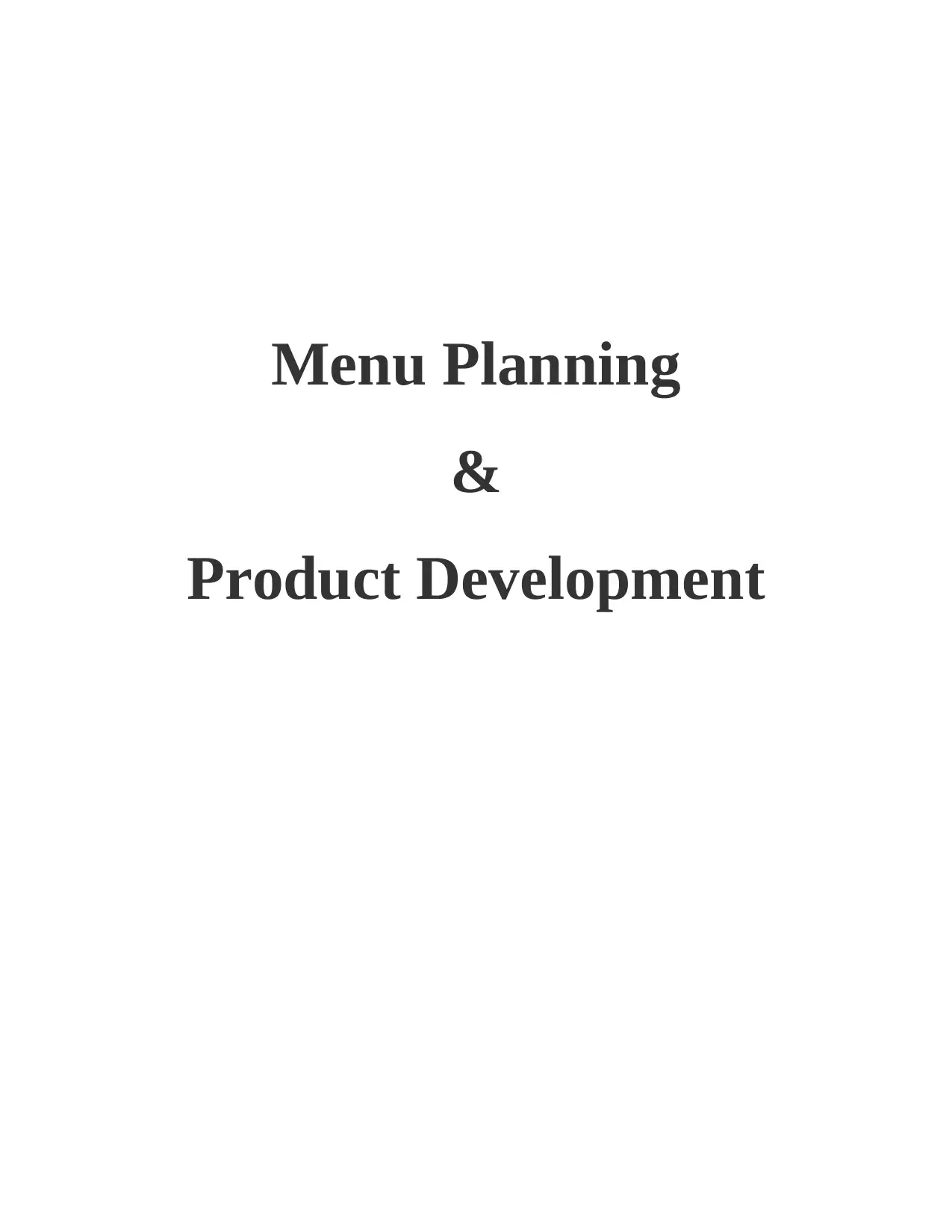
Menu Planning
&
Product Development
&
Product Development
Secure Best Marks with AI Grader
Need help grading? Try our AI Grader for instant feedback on your assignments.
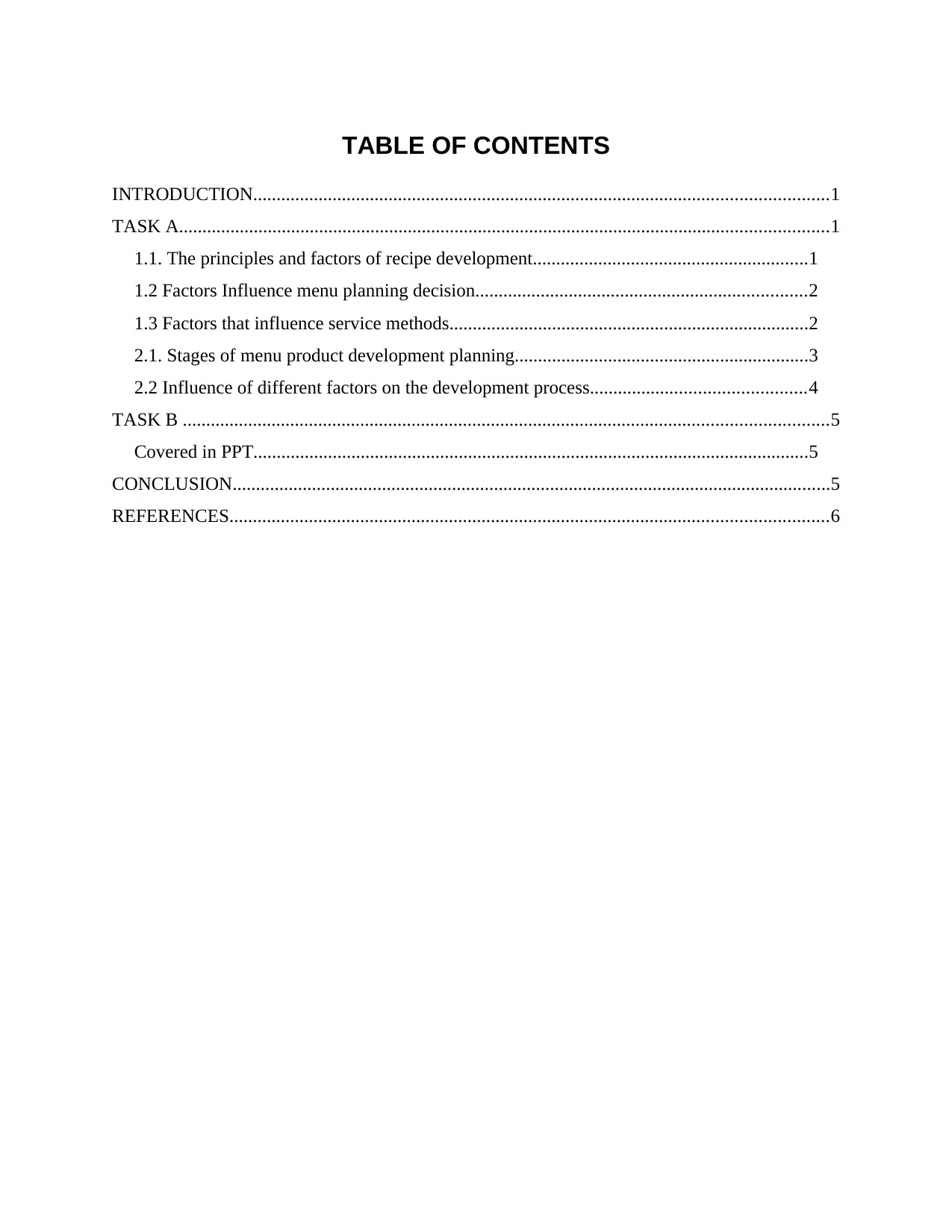
TABLE OF CONTENTS
INTRODUCTION...........................................................................................................................1
TASK A...........................................................................................................................................1
1.1. The principles and factors of recipe development...........................................................1
1.2 Factors Influence menu planning decision.......................................................................2
1.3 Factors that influence service methods.............................................................................2
2.1. Stages of menu product development planning...............................................................3
2.2 Influence of different factors on the development process..............................................4
TASK B ..........................................................................................................................................5
Covered in PPT.......................................................................................................................5
CONCLUSION................................................................................................................................5
REFERENCES................................................................................................................................6
INTRODUCTION...........................................................................................................................1
TASK A...........................................................................................................................................1
1.1. The principles and factors of recipe development...........................................................1
1.2 Factors Influence menu planning decision.......................................................................2
1.3 Factors that influence service methods.............................................................................2
2.1. Stages of menu product development planning...............................................................3
2.2 Influence of different factors on the development process..............................................4
TASK B ..........................................................................................................................................5
Covered in PPT.......................................................................................................................5
CONCLUSION................................................................................................................................5
REFERENCES................................................................................................................................6
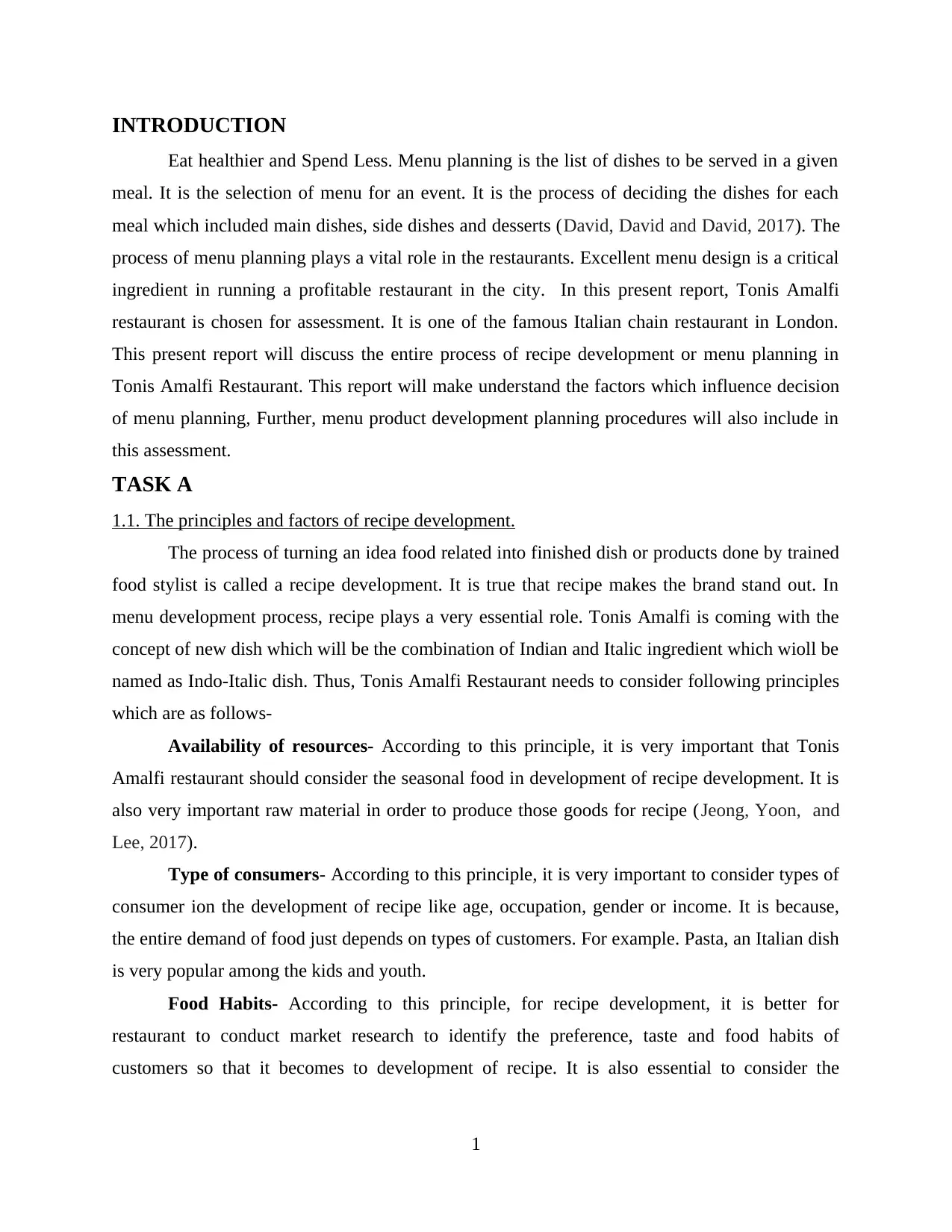
INTRODUCTION
Eat healthier and Spend Less. Menu planning is the list of dishes to be served in a given
meal. It is the selection of menu for an event. It is the process of deciding the dishes for each
meal which included main dishes, side dishes and desserts (David, David and David, 2017). The
process of menu planning plays a vital role in the restaurants. Excellent menu design is a critical
ingredient in running a profitable restaurant in the city. In this present report, Tonis Amalfi
restaurant is chosen for assessment. It is one of the famous Italian chain restaurant in London.
This present report will discuss the entire process of recipe development or menu planning in
Tonis Amalfi Restaurant. This report will make understand the factors which influence decision
of menu planning, Further, menu product development planning procedures will also include in
this assessment.
TASK A
1.1. The principles and factors of recipe development.
The process of turning an idea food related into finished dish or products done by trained
food stylist is called a recipe development. It is true that recipe makes the brand stand out. In
menu development process, recipe plays a very essential role. Tonis Amalfi is coming with the
concept of new dish which will be the combination of Indian and Italic ingredient which wioll be
named as Indo-Italic dish. Thus, Tonis Amalfi Restaurant needs to consider following principles
which are as follows-
Availability of resources- According to this principle, it is very important that Tonis
Amalfi restaurant should consider the seasonal food in development of recipe development. It is
also very important raw material in order to produce those goods for recipe (Jeong, Yoon, and
Lee, 2017).
Type of consumers- According to this principle, it is very important to consider types of
consumer ion the development of recipe like age, occupation, gender or income. It is because,
the entire demand of food just depends on types of customers. For example. Pasta, an Italian dish
is very popular among the kids and youth.
Food Habits- According to this principle, for recipe development, it is better for
restaurant to conduct market research to identify the preference, taste and food habits of
customers so that it becomes to development of recipe. It is also essential to consider the
1
Eat healthier and Spend Less. Menu planning is the list of dishes to be served in a given
meal. It is the selection of menu for an event. It is the process of deciding the dishes for each
meal which included main dishes, side dishes and desserts (David, David and David, 2017). The
process of menu planning plays a vital role in the restaurants. Excellent menu design is a critical
ingredient in running a profitable restaurant in the city. In this present report, Tonis Amalfi
restaurant is chosen for assessment. It is one of the famous Italian chain restaurant in London.
This present report will discuss the entire process of recipe development or menu planning in
Tonis Amalfi Restaurant. This report will make understand the factors which influence decision
of menu planning, Further, menu product development planning procedures will also include in
this assessment.
TASK A
1.1. The principles and factors of recipe development.
The process of turning an idea food related into finished dish or products done by trained
food stylist is called a recipe development. It is true that recipe makes the brand stand out. In
menu development process, recipe plays a very essential role. Tonis Amalfi is coming with the
concept of new dish which will be the combination of Indian and Italic ingredient which wioll be
named as Indo-Italic dish. Thus, Tonis Amalfi Restaurant needs to consider following principles
which are as follows-
Availability of resources- According to this principle, it is very important that Tonis
Amalfi restaurant should consider the seasonal food in development of recipe development. It is
also very important raw material in order to produce those goods for recipe (Jeong, Yoon, and
Lee, 2017).
Type of consumers- According to this principle, it is very important to consider types of
consumer ion the development of recipe like age, occupation, gender or income. It is because,
the entire demand of food just depends on types of customers. For example. Pasta, an Italian dish
is very popular among the kids and youth.
Food Habits- According to this principle, for recipe development, it is better for
restaurant to conduct market research to identify the preference, taste and food habits of
customers so that it becomes to development of recipe. It is also essential to consider the
1
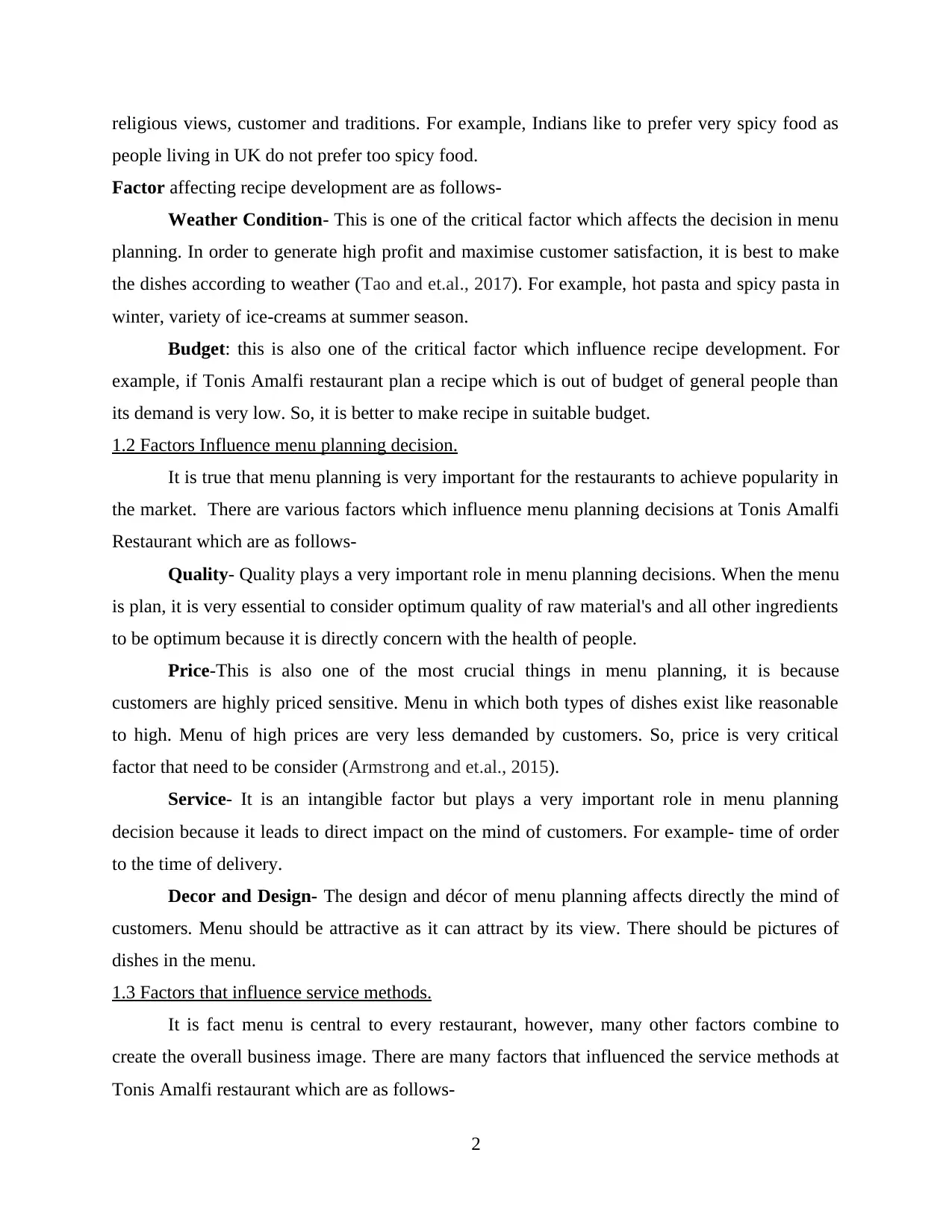
religious views, customer and traditions. For example, Indians like to prefer very spicy food as
people living in UK do not prefer too spicy food.
Factor affecting recipe development are as follows-
Weather Condition- This is one of the critical factor which affects the decision in menu
planning. In order to generate high profit and maximise customer satisfaction, it is best to make
the dishes according to weather (Tao and et.al., 2017). For example, hot pasta and spicy pasta in
winter, variety of ice-creams at summer season.
Budget: this is also one of the critical factor which influence recipe development. For
example, if Tonis Amalfi restaurant plan a recipe which is out of budget of general people than
its demand is very low. So, it is better to make recipe in suitable budget.
1.2 Factors Influence menu planning decision.
It is true that menu planning is very important for the restaurants to achieve popularity in
the market. There are various factors which influence menu planning decisions at Tonis Amalfi
Restaurant which are as follows-
Quality- Quality plays a very important role in menu planning decisions. When the menu
is plan, it is very essential to consider optimum quality of raw material's and all other ingredients
to be optimum because it is directly concern with the health of people.
Price-This is also one of the most crucial things in menu planning, it is because
customers are highly priced sensitive. Menu in which both types of dishes exist like reasonable
to high. Menu of high prices are very less demanded by customers. So, price is very critical
factor that need to be consider (Armstrong and et.al., 2015).
Service- It is an intangible factor but plays a very important role in menu planning
decision because it leads to direct impact on the mind of customers. For example- time of order
to the time of delivery.
Decor and Design- The design and décor of menu planning affects directly the mind of
customers. Menu should be attractive as it can attract by its view. There should be pictures of
dishes in the menu.
1.3 Factors that influence service methods.
It is fact menu is central to every restaurant, however, many other factors combine to
create the overall business image. There are many factors that influenced the service methods at
Tonis Amalfi restaurant which are as follows-
2
people living in UK do not prefer too spicy food.
Factor affecting recipe development are as follows-
Weather Condition- This is one of the critical factor which affects the decision in menu
planning. In order to generate high profit and maximise customer satisfaction, it is best to make
the dishes according to weather (Tao and et.al., 2017). For example, hot pasta and spicy pasta in
winter, variety of ice-creams at summer season.
Budget: this is also one of the critical factor which influence recipe development. For
example, if Tonis Amalfi restaurant plan a recipe which is out of budget of general people than
its demand is very low. So, it is better to make recipe in suitable budget.
1.2 Factors Influence menu planning decision.
It is true that menu planning is very important for the restaurants to achieve popularity in
the market. There are various factors which influence menu planning decisions at Tonis Amalfi
Restaurant which are as follows-
Quality- Quality plays a very important role in menu planning decisions. When the menu
is plan, it is very essential to consider optimum quality of raw material's and all other ingredients
to be optimum because it is directly concern with the health of people.
Price-This is also one of the most crucial things in menu planning, it is because
customers are highly priced sensitive. Menu in which both types of dishes exist like reasonable
to high. Menu of high prices are very less demanded by customers. So, price is very critical
factor that need to be consider (Armstrong and et.al., 2015).
Service- It is an intangible factor but plays a very important role in menu planning
decision because it leads to direct impact on the mind of customers. For example- time of order
to the time of delivery.
Decor and Design- The design and décor of menu planning affects directly the mind of
customers. Menu should be attractive as it can attract by its view. There should be pictures of
dishes in the menu.
1.3 Factors that influence service methods.
It is fact menu is central to every restaurant, however, many other factors combine to
create the overall business image. There are many factors that influenced the service methods at
Tonis Amalfi restaurant which are as follows-
2
Secure Best Marks with AI Grader
Need help grading? Try our AI Grader for instant feedback on your assignments.

Size of Business- Restaurants located at roadside offering services is completely different
from the restaurants are 5 Star hotels. The service quality is top in 5 star restaurants in
comparison to roadside restaurants (Kim and et.al., 2015). Tonis Amalfi offers table services to
their customers.
Nature of Menu- This is also one of the important factor which influenced the service
methods. For example- an extensive dish requires fast and up to the mark services in order to
meet the current trends or to set a new trend in the industry.
Budget- This factor also affects the service methods. The serve offers by budgeted
restaurant may not be hight impressive. But the selection of service depends on customer's
budget.
Ways Tonis Amalfi could use to offered services to there customers are as follows-
Buffer System- it is a system of serving meals to customers in which dishes are placed in
public area where everyone can take and eat the food. The benefit of buffer system is that
restaurant does not need large number of waiters (Lee, Wall and Kovacs, 2015). On the other
hand, buffer system is suitable in parties, occasion not in the restaurants as customers does not
feel satisfied with this service.
Table Ordering- This is most common method which is used by most of the restaurants
in offering food to the customers. In Tonis Amalfi, food is served by this system. In table
ordering, customer check the menu and make an order to the waiters. The advantage of this
system is high level of customer satisfaction. Beside this, restaurant requires optimum workforce
to tackle all the tables which raise the cost of operations.
Online Selling- This is also one of the best method to attract customers as now people
have become highly advance in terms of technology. Tonis Amalfi could use the online selling of
food items to the customers (De Massis and et.al., 2016).
2.1. Stages of menu product development planning.
There are different stages of product development planning which are very necessary to
consider in menu product development planning which are as following. These stages are very
helpful in the development of new food concept at Tonis Amalfi (Indo-Italian)
Know the Occasion- This is the first stage where it is very important to know the
occasion at the very first stage. The managers of Tonis Amalfi should always keep in mind that
the taste and preference of customers changes as per the occasion at any time.
3
from the restaurants are 5 Star hotels. The service quality is top in 5 star restaurants in
comparison to roadside restaurants (Kim and et.al., 2015). Tonis Amalfi offers table services to
their customers.
Nature of Menu- This is also one of the important factor which influenced the service
methods. For example- an extensive dish requires fast and up to the mark services in order to
meet the current trends or to set a new trend in the industry.
Budget- This factor also affects the service methods. The serve offers by budgeted
restaurant may not be hight impressive. But the selection of service depends on customer's
budget.
Ways Tonis Amalfi could use to offered services to there customers are as follows-
Buffer System- it is a system of serving meals to customers in which dishes are placed in
public area where everyone can take and eat the food. The benefit of buffer system is that
restaurant does not need large number of waiters (Lee, Wall and Kovacs, 2015). On the other
hand, buffer system is suitable in parties, occasion not in the restaurants as customers does not
feel satisfied with this service.
Table Ordering- This is most common method which is used by most of the restaurants
in offering food to the customers. In Tonis Amalfi, food is served by this system. In table
ordering, customer check the menu and make an order to the waiters. The advantage of this
system is high level of customer satisfaction. Beside this, restaurant requires optimum workforce
to tackle all the tables which raise the cost of operations.
Online Selling- This is also one of the best method to attract customers as now people
have become highly advance in terms of technology. Tonis Amalfi could use the online selling of
food items to the customers (De Massis and et.al., 2016).
2.1. Stages of menu product development planning.
There are different stages of product development planning which are very necessary to
consider in menu product development planning which are as following. These stages are very
helpful in the development of new food concept at Tonis Amalfi (Indo-Italian)
Know the Occasion- This is the first stage where it is very important to know the
occasion at the very first stage. The managers of Tonis Amalfi should always keep in mind that
the taste and preference of customers changes as per the occasion at any time.
3
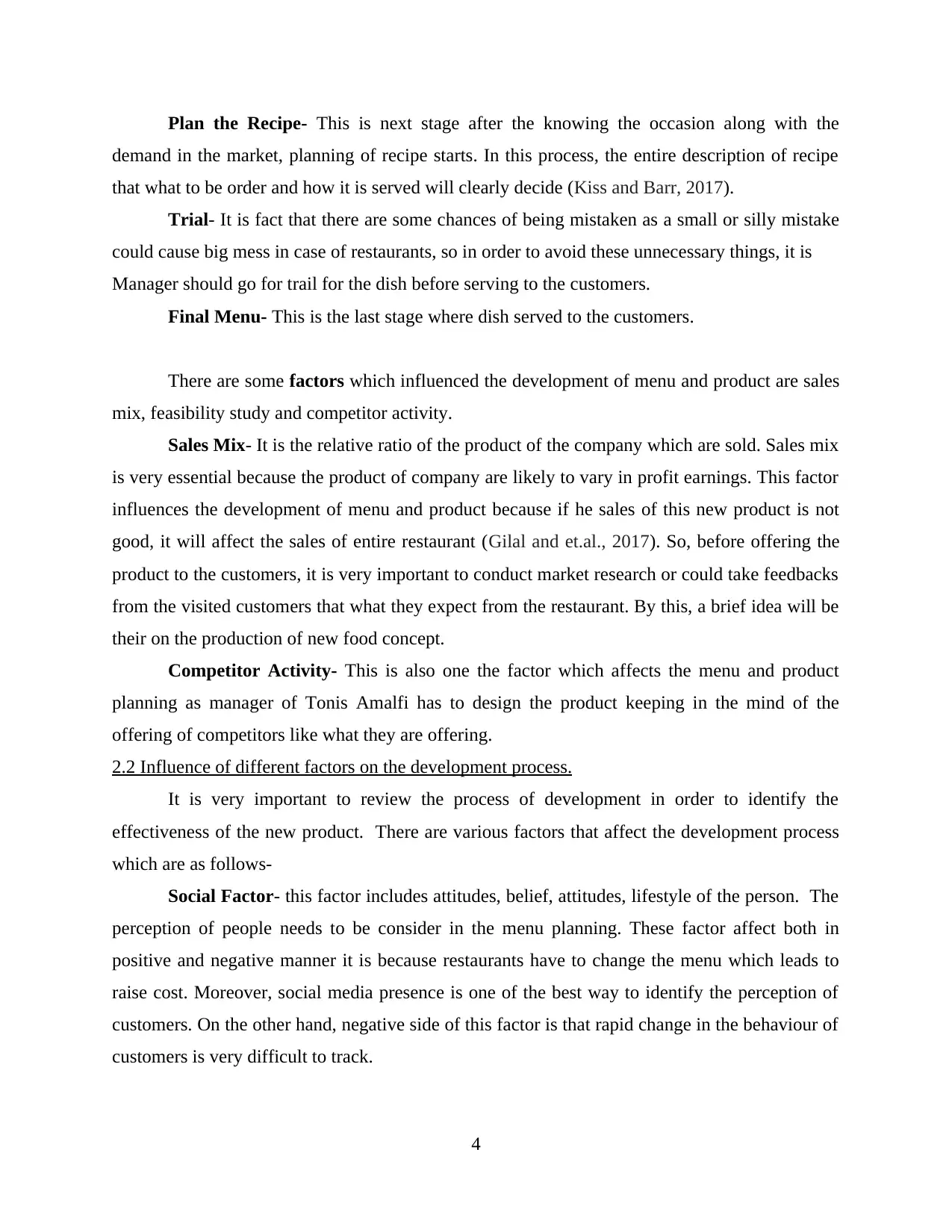
Plan the Recipe- This is next stage after the knowing the occasion along with the
demand in the market, planning of recipe starts. In this process, the entire description of recipe
that what to be order and how it is served will clearly decide (Kiss and Barr, 2017).
Trial- It is fact that there are some chances of being mistaken as a small or silly mistake
could cause big mess in case of restaurants, so in order to avoid these unnecessary things, it is
Manager should go for trail for the dish before serving to the customers.
Final Menu- This is the last stage where dish served to the customers.
There are some factors which influenced the development of menu and product are sales
mix, feasibility study and competitor activity.
Sales Mix- It is the relative ratio of the product of the company which are sold. Sales mix
is very essential because the product of company are likely to vary in profit earnings. This factor
influences the development of menu and product because if he sales of this new product is not
good, it will affect the sales of entire restaurant (Gilal and et.al., 2017). So, before offering the
product to the customers, it is very important to conduct market research or could take feedbacks
from the visited customers that what they expect from the restaurant. By this, a brief idea will be
their on the production of new food concept.
Competitor Activity- This is also one the factor which affects the menu and product
planning as manager of Tonis Amalfi has to design the product keeping in the mind of the
offering of competitors like what they are offering.
2.2 Influence of different factors on the development process.
It is very important to review the process of development in order to identify the
effectiveness of the new product. There are various factors that affect the development process
which are as follows-
Social Factor- this factor includes attitudes, belief, attitudes, lifestyle of the person. The
perception of people needs to be consider in the menu planning. These factor affect both in
positive and negative manner it is because restaurants have to change the menu which leads to
raise cost. Moreover, social media presence is one of the best way to identify the perception of
customers. On the other hand, negative side of this factor is that rapid change in the behaviour of
customers is very difficult to track.
4
demand in the market, planning of recipe starts. In this process, the entire description of recipe
that what to be order and how it is served will clearly decide (Kiss and Barr, 2017).
Trial- It is fact that there are some chances of being mistaken as a small or silly mistake
could cause big mess in case of restaurants, so in order to avoid these unnecessary things, it is
Manager should go for trail for the dish before serving to the customers.
Final Menu- This is the last stage where dish served to the customers.
There are some factors which influenced the development of menu and product are sales
mix, feasibility study and competitor activity.
Sales Mix- It is the relative ratio of the product of the company which are sold. Sales mix
is very essential because the product of company are likely to vary in profit earnings. This factor
influences the development of menu and product because if he sales of this new product is not
good, it will affect the sales of entire restaurant (Gilal and et.al., 2017). So, before offering the
product to the customers, it is very important to conduct market research or could take feedbacks
from the visited customers that what they expect from the restaurant. By this, a brief idea will be
their on the production of new food concept.
Competitor Activity- This is also one the factor which affects the menu and product
planning as manager of Tonis Amalfi has to design the product keeping in the mind of the
offering of competitors like what they are offering.
2.2 Influence of different factors on the development process.
It is very important to review the process of development in order to identify the
effectiveness of the new product. There are various factors that affect the development process
which are as follows-
Social Factor- this factor includes attitudes, belief, attitudes, lifestyle of the person. The
perception of people needs to be consider in the menu planning. These factor affect both in
positive and negative manner it is because restaurants have to change the menu which leads to
raise cost. Moreover, social media presence is one of the best way to identify the perception of
customers. On the other hand, negative side of this factor is that rapid change in the behaviour of
customers is very difficult to track.
4
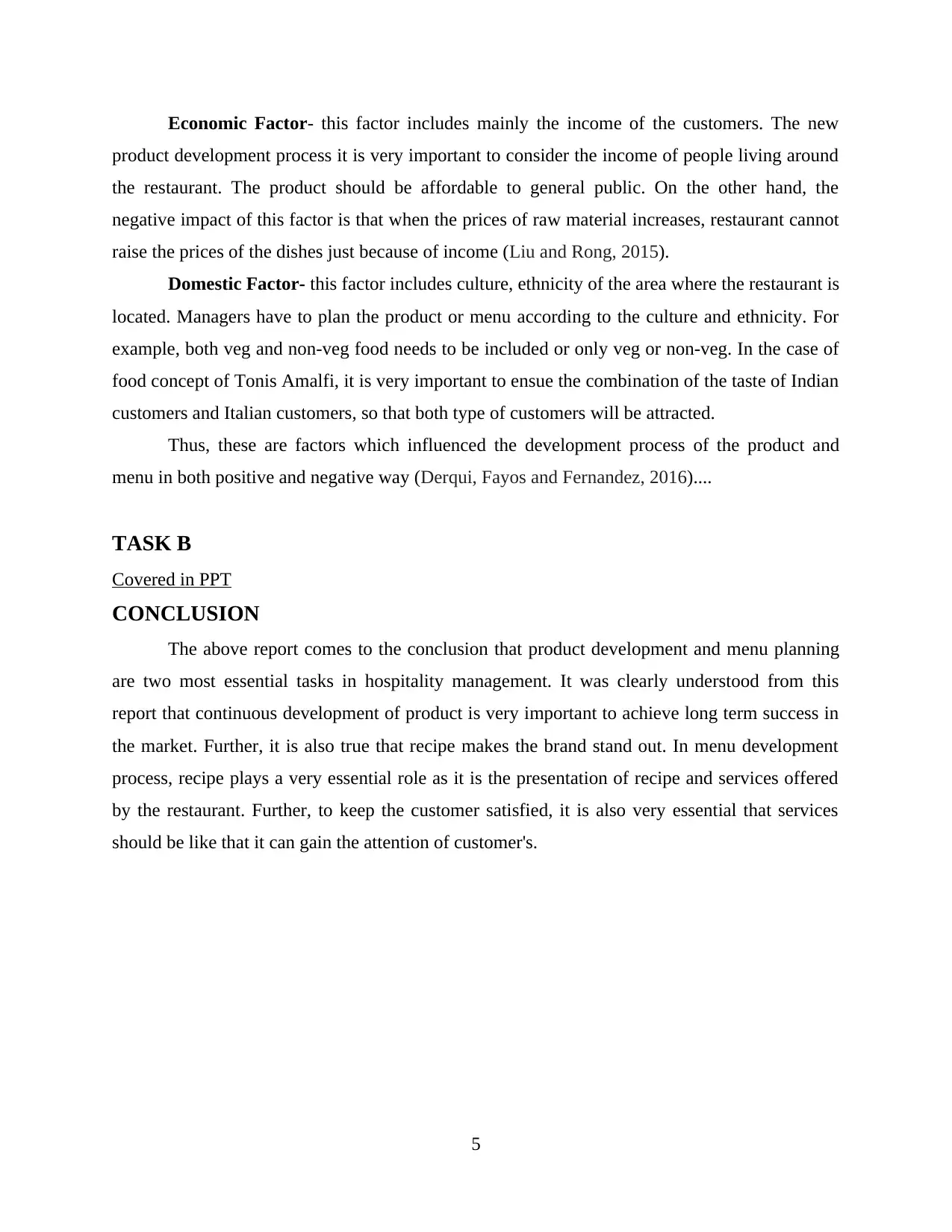
Economic Factor- this factor includes mainly the income of the customers. The new
product development process it is very important to consider the income of people living around
the restaurant. The product should be affordable to general public. On the other hand, the
negative impact of this factor is that when the prices of raw material increases, restaurant cannot
raise the prices of the dishes just because of income (Liu and Rong, 2015).
Domestic Factor- this factor includes culture, ethnicity of the area where the restaurant is
located. Managers have to plan the product or menu according to the culture and ethnicity. For
example, both veg and non-veg food needs to be included or only veg or non-veg. In the case of
food concept of Tonis Amalfi, it is very important to ensue the combination of the taste of Indian
customers and Italian customers, so that both type of customers will be attracted.
Thus, these are factors which influenced the development process of the product and
menu in both positive and negative way (Derqui, Fayos and Fernandez, 2016)....
TASK B
Covered in PPT
CONCLUSION
The above report comes to the conclusion that product development and menu planning
are two most essential tasks in hospitality management. It was clearly understood from this
report that continuous development of product is very important to achieve long term success in
the market. Further, it is also true that recipe makes the brand stand out. In menu development
process, recipe plays a very essential role as it is the presentation of recipe and services offered
by the restaurant. Further, to keep the customer satisfied, it is also very essential that services
should be like that it can gain the attention of customer's.
5
product development process it is very important to consider the income of people living around
the restaurant. The product should be affordable to general public. On the other hand, the
negative impact of this factor is that when the prices of raw material increases, restaurant cannot
raise the prices of the dishes just because of income (Liu and Rong, 2015).
Domestic Factor- this factor includes culture, ethnicity of the area where the restaurant is
located. Managers have to plan the product or menu according to the culture and ethnicity. For
example, both veg and non-veg food needs to be included or only veg or non-veg. In the case of
food concept of Tonis Amalfi, it is very important to ensue the combination of the taste of Indian
customers and Italian customers, so that both type of customers will be attracted.
Thus, these are factors which influenced the development process of the product and
menu in both positive and negative way (Derqui, Fayos and Fernandez, 2016)....
TASK B
Covered in PPT
CONCLUSION
The above report comes to the conclusion that product development and menu planning
are two most essential tasks in hospitality management. It was clearly understood from this
report that continuous development of product is very important to achieve long term success in
the market. Further, it is also true that recipe makes the brand stand out. In menu development
process, recipe plays a very essential role as it is the presentation of recipe and services offered
by the restaurant. Further, to keep the customer satisfied, it is also very essential that services
should be like that it can gain the attention of customer's.
5
Paraphrase This Document
Need a fresh take? Get an instant paraphrase of this document with our AI Paraphraser
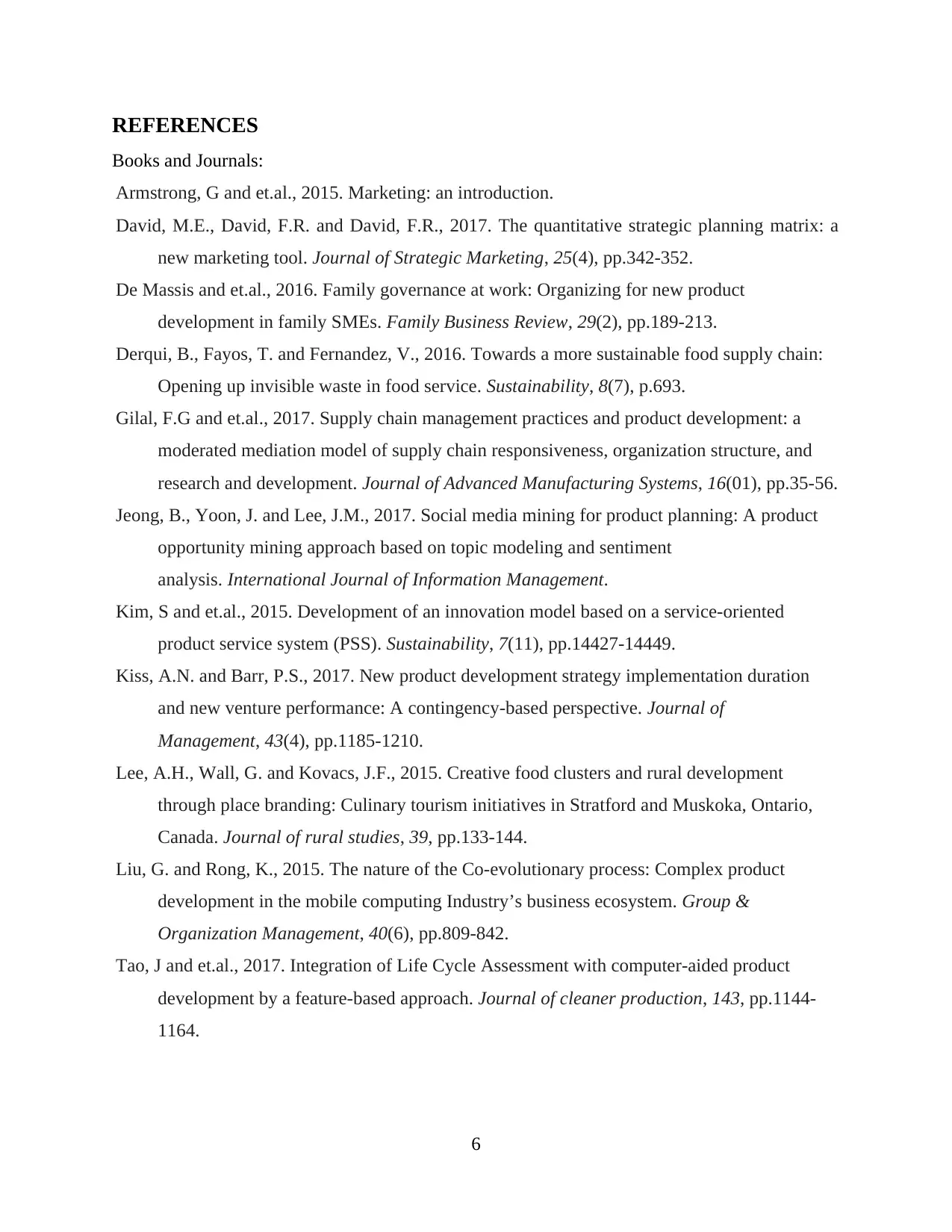
REFERENCES
Books and Journals:
Armstrong, G and et.al., 2015. Marketing: an introduction.
David, M.E., David, F.R. and David, F.R., 2017. The quantitative strategic planning matrix: a
new marketing tool. Journal of Strategic Marketing, 25(4), pp.342-352.
De Massis and et.al., 2016. Family governance at work: Organizing for new product
development in family SMEs. Family Business Review, 29(2), pp.189-213.
Derqui, B., Fayos, T. and Fernandez, V., 2016. Towards a more sustainable food supply chain:
Opening up invisible waste in food service. Sustainability, 8(7), p.693.
Gilal, F.G and et.al., 2017. Supply chain management practices and product development: a
moderated mediation model of supply chain responsiveness, organization structure, and
research and development. Journal of Advanced Manufacturing Systems, 16(01), pp.35-56.
Jeong, B., Yoon, J. and Lee, J.M., 2017. Social media mining for product planning: A product
opportunity mining approach based on topic modeling and sentiment
analysis. International Journal of Information Management.
Kim, S and et.al., 2015. Development of an innovation model based on a service-oriented
product service system (PSS). Sustainability, 7(11), pp.14427-14449.
Kiss, A.N. and Barr, P.S., 2017. New product development strategy implementation duration
and new venture performance: A contingency-based perspective. Journal of
Management, 43(4), pp.1185-1210.
Lee, A.H., Wall, G. and Kovacs, J.F., 2015. Creative food clusters and rural development
through place branding: Culinary tourism initiatives in Stratford and Muskoka, Ontario,
Canada. Journal of rural studies, 39, pp.133-144.
Liu, G. and Rong, K., 2015. The nature of the Co-evolutionary process: Complex product
development in the mobile computing Industry’s business ecosystem. Group &
Organization Management, 40(6), pp.809-842.
Tao, J and et.al., 2017. Integration of Life Cycle Assessment with computer-aided product
development by a feature-based approach. Journal of cleaner production, 143, pp.1144-
1164.
6
Books and Journals:
Armstrong, G and et.al., 2015. Marketing: an introduction.
David, M.E., David, F.R. and David, F.R., 2017. The quantitative strategic planning matrix: a
new marketing tool. Journal of Strategic Marketing, 25(4), pp.342-352.
De Massis and et.al., 2016. Family governance at work: Organizing for new product
development in family SMEs. Family Business Review, 29(2), pp.189-213.
Derqui, B., Fayos, T. and Fernandez, V., 2016. Towards a more sustainable food supply chain:
Opening up invisible waste in food service. Sustainability, 8(7), p.693.
Gilal, F.G and et.al., 2017. Supply chain management practices and product development: a
moderated mediation model of supply chain responsiveness, organization structure, and
research and development. Journal of Advanced Manufacturing Systems, 16(01), pp.35-56.
Jeong, B., Yoon, J. and Lee, J.M., 2017. Social media mining for product planning: A product
opportunity mining approach based on topic modeling and sentiment
analysis. International Journal of Information Management.
Kim, S and et.al., 2015. Development of an innovation model based on a service-oriented
product service system (PSS). Sustainability, 7(11), pp.14427-14449.
Kiss, A.N. and Barr, P.S., 2017. New product development strategy implementation duration
and new venture performance: A contingency-based perspective. Journal of
Management, 43(4), pp.1185-1210.
Lee, A.H., Wall, G. and Kovacs, J.F., 2015. Creative food clusters and rural development
through place branding: Culinary tourism initiatives in Stratford and Muskoka, Ontario,
Canada. Journal of rural studies, 39, pp.133-144.
Liu, G. and Rong, K., 2015. The nature of the Co-evolutionary process: Complex product
development in the mobile computing Industry’s business ecosystem. Group &
Organization Management, 40(6), pp.809-842.
Tao, J and et.al., 2017. Integration of Life Cycle Assessment with computer-aided product
development by a feature-based approach. Journal of cleaner production, 143, pp.1144-
1164.
6

7
1 out of 9
Related Documents
Your All-in-One AI-Powered Toolkit for Academic Success.
+13062052269
info@desklib.com
Available 24*7 on WhatsApp / Email
![[object Object]](/_next/static/media/star-bottom.7253800d.svg)
Unlock your academic potential
© 2024 | Zucol Services PVT LTD | All rights reserved.





